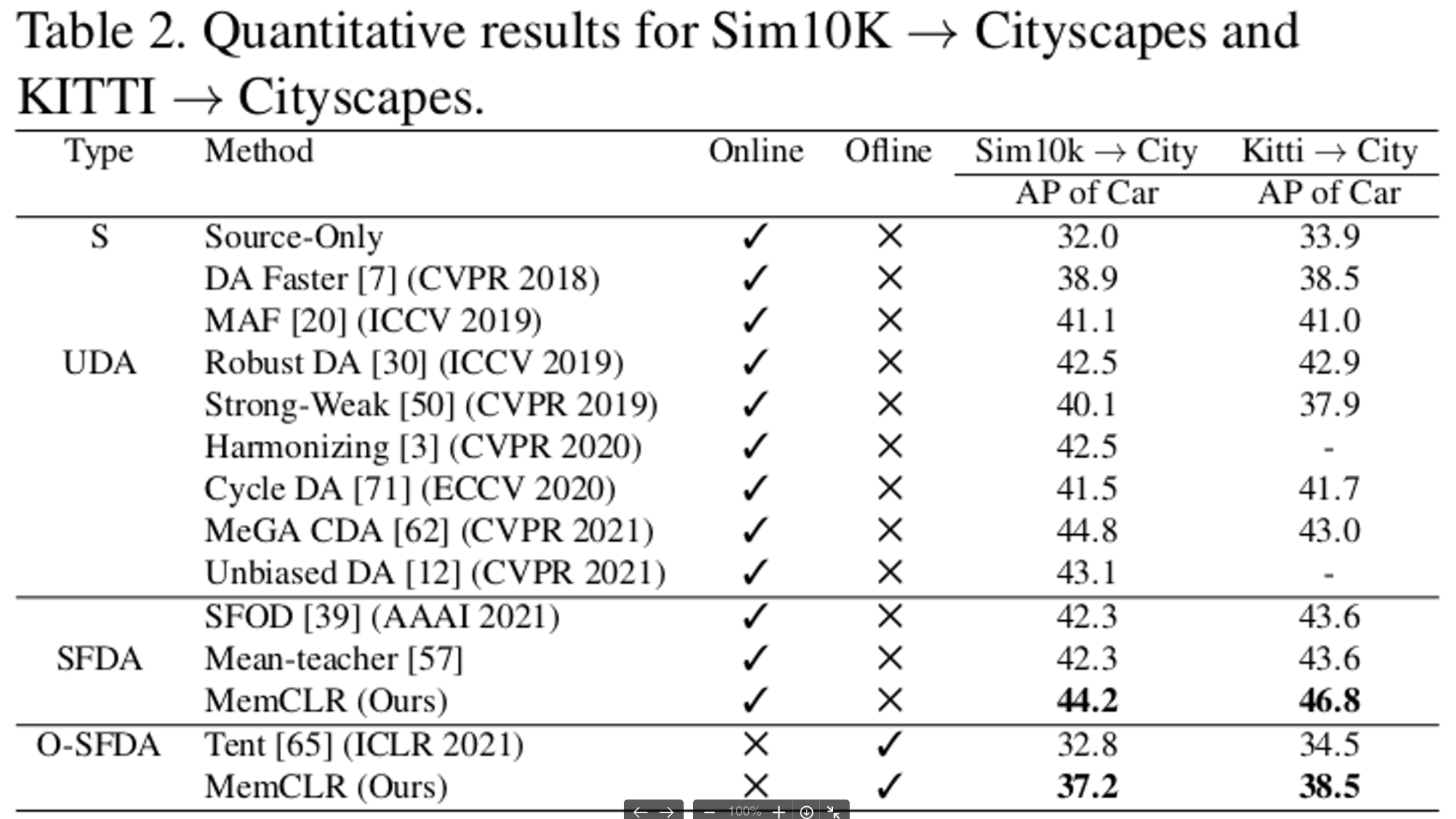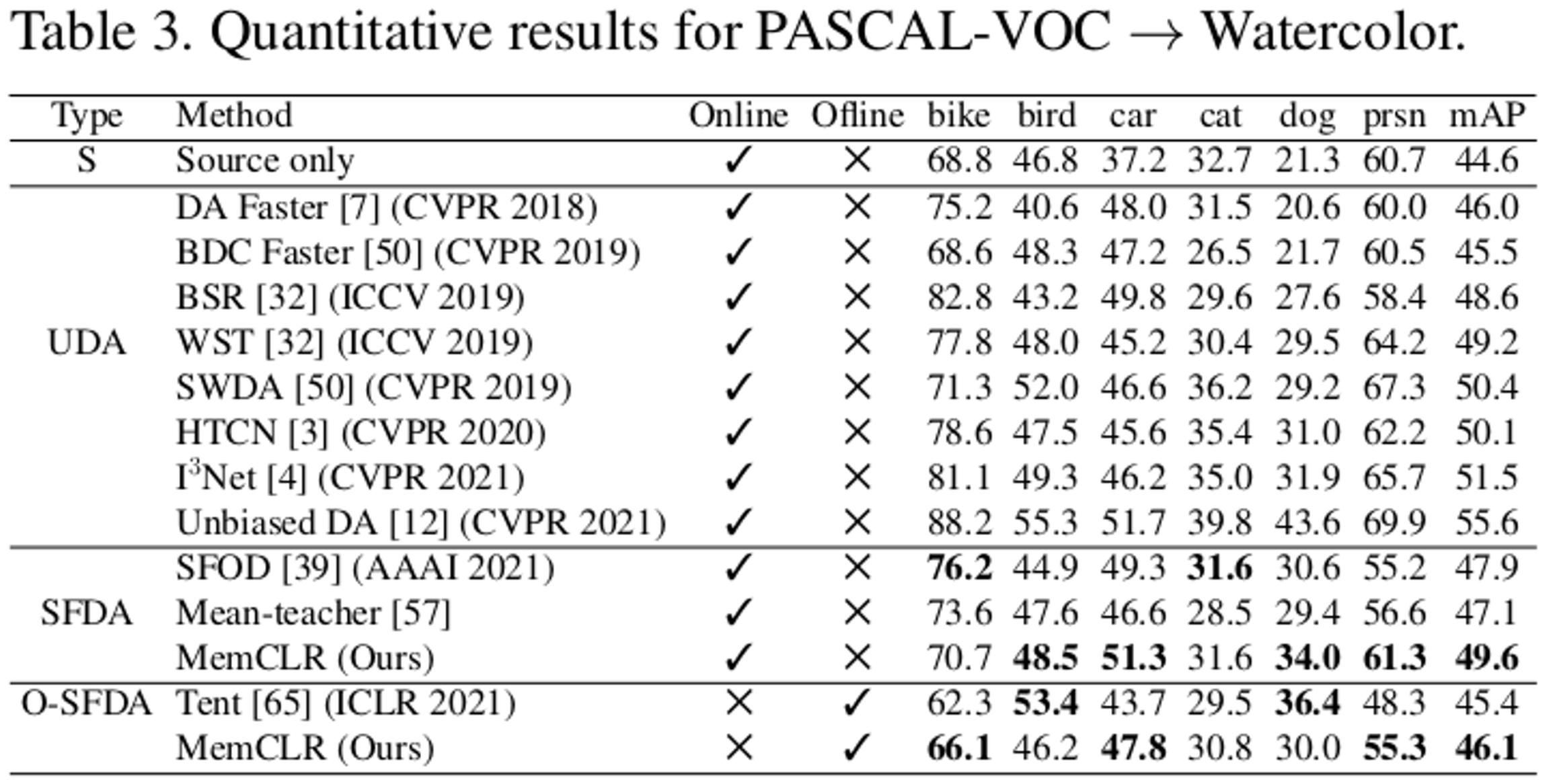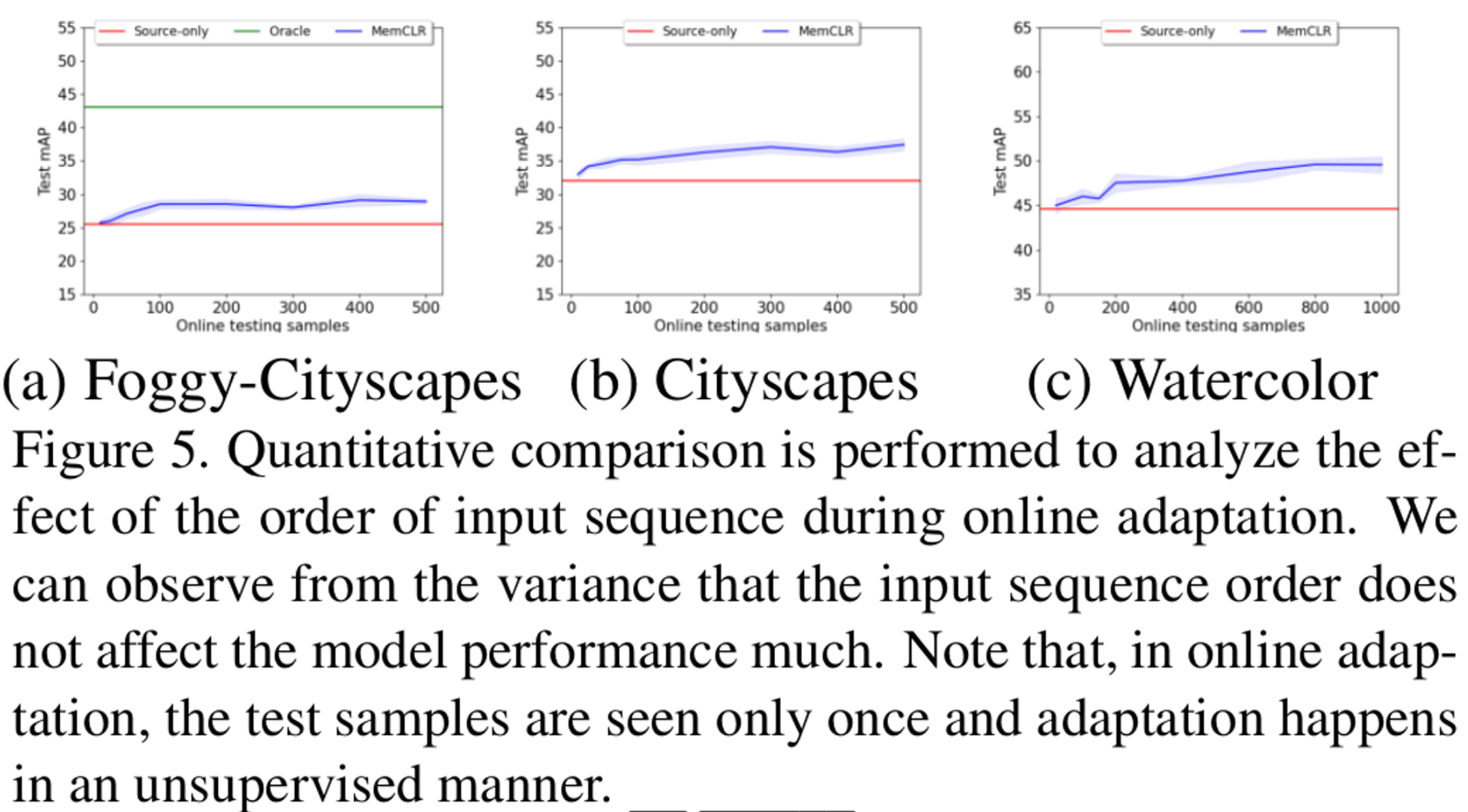[SFDA][OD] MemXFormer: Towards Online Domain Adaptive Object Detection
[SFDA][OD] MemXFormer: Towards Online Domain Adaptive Object Detection
- paper : https://openaccess.thecvf.com/content/WACV2023/papers/VS_Towards_Online_Domain_Adaptive_Object_Detection_WACV_2023_paper.pdf
- git :https://github.com/Vibashan/online-da
- WACV2023 accpeted (인용수: 21회, ‘23.12.29 기준)
- downstream task: Source-Free Domain Adaptation (SFDA) for OD
Abstract
- Contribution
- Transformer기반의 MemXFormer module을 통해 online으로 target domain을 대표하는 prototypes를 업데이트하여 실시간으로 adaptation이 가능하도록 구현함
- Online/Offline으로 SFDA에서 OD를 푼 최초의 논문
1. Introduction
-
OD Task 수행시 다양한 Target domain에서 offline으로 adaptation하는 것은 infeasible하므로, online/offline adaptation 모두 해봐야 한다고 문제제기한 최초의 논문
- Online-SFDA(Source-Free Domain Adaptation) setting
-
두 가지 기술을 Online-SFDA에 적절히 변형하여 활용
-
Self-Training : Mean teacher를 EMA로 업데이트하여 pseudo target label로 학습
- 단점 : Target domain 분포를 fully 추출할 수 없음 → Robust target feature 학습이 안됨
- 해결 : Memory module을 두어 target domain 을 approximately 추출
-
Contrastive Learning

- $z_i, z_j$: i번째 feature, j번째 feature (같은 이미지, 다른 augmentation view)
- 단점 :
- Classification task 풀때 주로 사용. Image-level로 Augmentation 수행하여 복제함. → Computational cost가 많이 듦.(?)
- Large batch size를 요구함
- 해결 : MemXFormer에 Teacher feature의 cross-attention된 값을 MemXFormer를 통해 Positive, Negative pair 생성 → temporal ensemble feature 를 기반으로 Contrastive Learning 수행. (RoI Features)
-
2. Related Work
Online Adaptation
-
SFDA (Source Free Domain Adaptation)
- Deploy 환경에서는 Source data를 활용해서 adaptation 할 수 없으므로, Source image, label은 사용하지 않음
- Target unlabel image만 사용
-
Online-SFDA

- Large batch size는 infeasible하므로, one-by-one 연속적으로 들어오는 setting으로 adaptation 수행
Contrastive Learning
- Positive pair는 당기고, Negative pair는 밀도록 학습 → Strong feature representation 학습이 가능
- 일반적으론 자기 자신(image) 을 다른 augmentation 준 image를 positive, batch 내 다른 image를 negative로 학습 → Large batch size 요구
- Small batch size에도 Memory를 활용하면 positive, negative (hard negative)를 제공할 수 있음
3. Approach
- Overall Diagram

Memory-based Contrastive Learning
-
MemXFormer
-
cross-attention transformer-based memory module
-
target의 distribution shift 정보를 저장 및 online-adaptation 환경에서 Contrastive Learning에 사용될 pair를 제공 $M={m^i \in \mathbb{R}^{1 \times C}}^{N_l}$
- $m^i$: memory module에 저장된 temporal ensemble RoI feature (prototype 역할)
-
주요기능
- read : Student RoI feature를 query로 활용해서 weighted sum된 similar / non-similar memory를 불러옴.
- write : Teacher RoI feature를 저장함.
-
Write
- Student보다 reliable한 값을 출력하는 Teacher의 RoI feature를 Memory에 저장 $F_t={f_t^i \in \mathbb{R}^{1 \times C}}_{i=1}^{N_f}$
- Key, Value : Teacher RoI feature $k_t^i=W_kf_t^i \text{, }v_t^i=W_vf_t^i$
- Query : memory 저장된 vector
- Similarity matrix $s_t^{i,j}=\frac{exp(m^j(k_t^i)^T)}{\sum_{l \in M}exp(m^l(k_t^i)^T}$
- update equation $m_j=F(m_j+\sum_{i \in V}s_t^{(i,j)}v_t^i)$
- F=L2 norm
- Student보다 reliable한 값을 출력하는 Teacher의 RoI feature를 Memory에 저장 $F_t={f_t^i \in \mathbb{R}^{1 \times C}}_{i=1}^{N_f}$
-
Read
$q_s^i=W_qf_s^i \text{, }s_s(i,j)=\frac{exp(q_s^i(m^j)^T)}{\sum_{l \in M}exp(q_s^i(m^l)^T)}$
- Query : Student RoI Feature $q_s^i$
- Key, Value : Memory $m^l$
- positive pairs : $N_l \text{개 중에} N_f$를 선택 $p_s^i=\sum_{j \in M}s_s^{(i,j)}m^j\text{, } P_s={p_s^i}_{i=1}^{N_f}$
- negative pairs : Similairity가 하위 10%인 것들로 정의 $N_s={m_i^n}_{i=1}^{N_s}$
-
Memory contrasive loss (MemCLR)
-
-
Total Loss
4. Experiments
Dataset
- Scenario
- clear-weather to foggy-weather
- real to artistic
- synthetic to real
- cross-camera adaptation
- On/Offline
- Offline : SFDA setting.
- Train data : Target-train set
- Test data : Target-test set
- Online : Online-SFDA setting
- Train data : Target-test set
- Test data : Target-test set
- Offline : SFDA setting.
Implementation Details
- Model : Faster-RCNN w/ ResNet50 backbone
- Resize : shorter side to be 600
- batch size : 1
- EMA : $\alpha=0.99$
- Threshold : 0.9
- Optimizer : SGD w/ learning rate 1e-3 & momentum update 0.9
- epoch : 10
- Evaluation Metric : mAP@0.5
Cityscapes to Foggy Cityscapes

Synthetic to Real world Adaptation & Cross Camera Adaptation
- Synthetic to Real: Sim10K → Citisycapes
- Cross Camera: Cityscapes → Kitti

Real to artistic adaptation
- Pascal VOC (Real world) → WaterColor (Cartoon)

Ablation Studies

-
SupCon : Supervised Contrastive Loss
-
T-SNE

- RoI Features of 500 test images
-
Test sample order에 따른 영항 분석

- 분산이 적으므로 순서가 상관 없다고 함(?) → correlated image가 애초에 아니여서 그런듯..